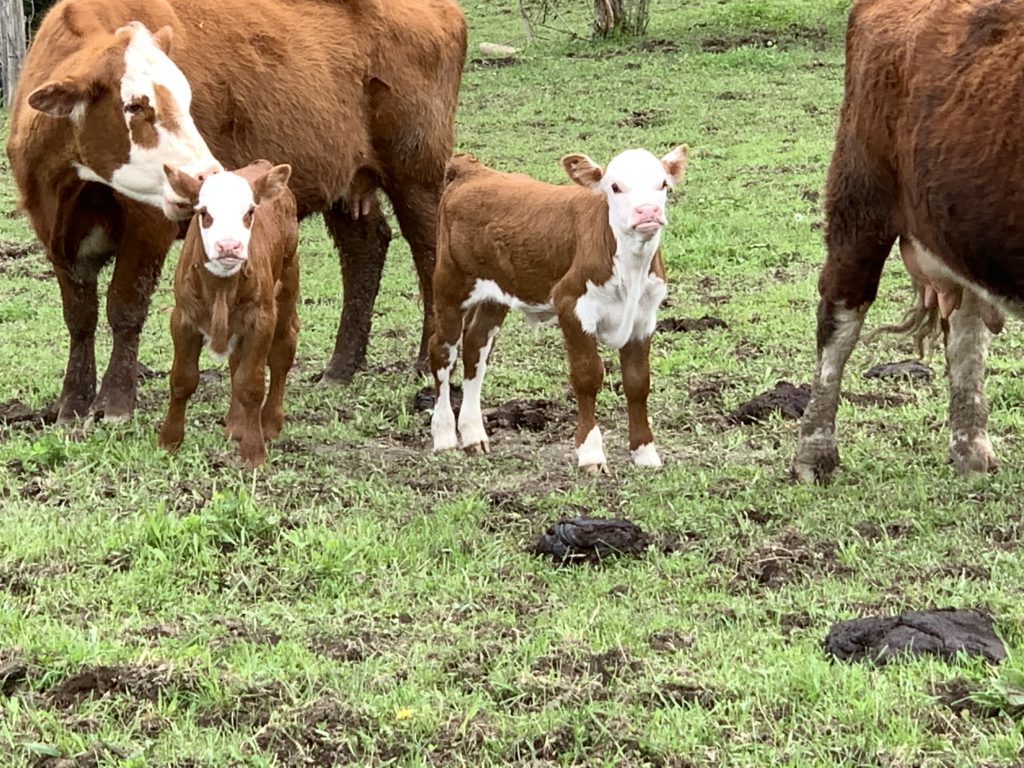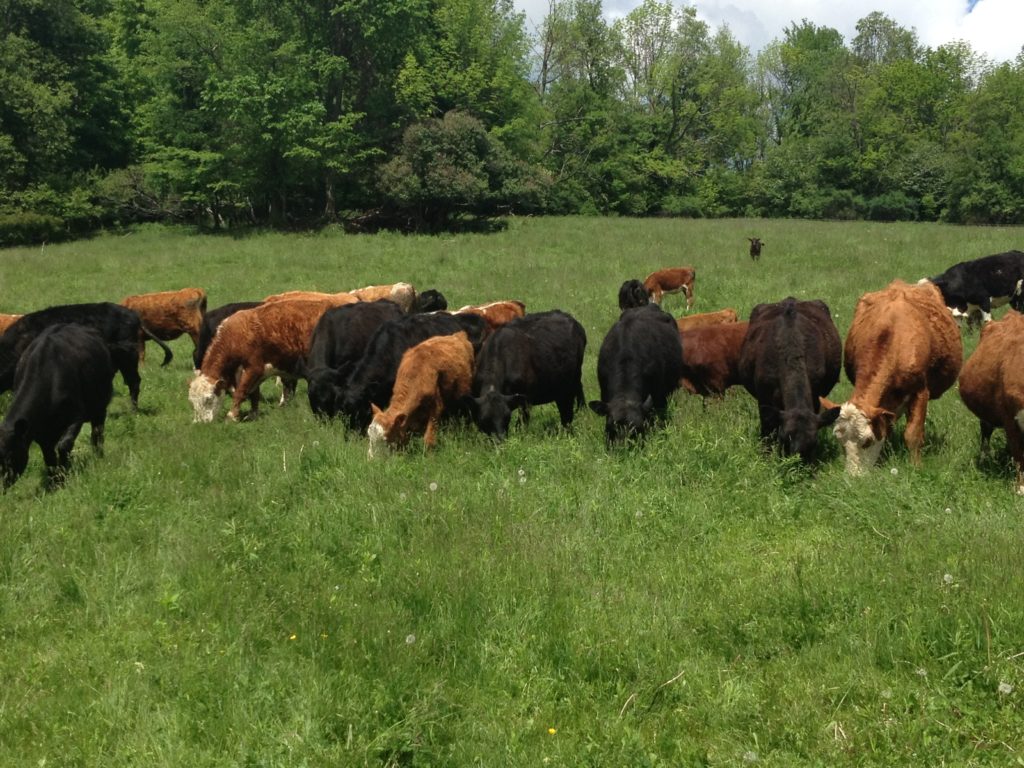What’s Your Beef?
So you think that you would like to raise some beef cattle on your small farm?
This is the first installment of a multi-part series of articles on raising beef cattle on the small farm.

Some of the author’s baby calves from Spring 2020.
Rich Taber / CCE Chenango
In this series of articles in the Small Farms Quarterly, I will outline many of the topic areas that you will need to gain knowledge and skills in. First off, what do I know about beef cattle? Well, I have raised them on my farm in Central New York for many years along with sheep, dairy heifers, and a variety of pastured poultry. Additionally, my wife Wendy has had a retail meat business from which she recently retired just before the COVID pandemic came along. We currently have a small cow-calf herd of mother cows and at any given time a variety of young stock from babies, to yearlings, to two years old animals and one or two breeding bulls on hand. We also practice rotational grazing during the warmer months of the year, and make a lot of our own hay to feed these creatures for the 7 months or so of the years when grass does not grow.
So why would you want to raise beef cattle? There might be several reasons. You may have just purchased your property in the country and are thinking of turning some of that small farm resource into cash. That’s a reasonably good motive. You might also want to utilize some pasture land on your property. That’s a good motive too. You may also want to enjoy some healthy, delicious meat that you raised yourself, and which did not come from a multi-thousand animal feedlot. Great motive! You would like to make a lot of money from your beef operation. Ah, maybe, maybe not. What do we need to know?
Hardly a week goes by that someone doesn’t call me looking for advice on how to get into the beef business. The perception is that once you raise the animals, the money will just roll in. I don’t mean to rain on anyone’s parade, but that seldom happens. You can raise some animals and garner a small profit, but we will get into all of that in a later installment.

Key considerations of infrastructure are good pastures, good fencing, a good animal handling facility. Some of the author’s cattle are pictured here in a healthy pasture.
Rich Taber / CCE Chenango
So what are some of the first considerations to take into account? Well, you need to decide on which method of keeping animals are you going to consider? Most people think of the traditional cow-calf operation which consists of a few cows, a bull, and a yearly calving schedule. Then they raise the calves, and try finishing them to slaughter weight to between 18 to 24 months. Another method is to simply purchase some feeder calves from someone in the springtime, and finish them out that year. Or you could plan on selling the calves from your cow-calf operation during the first fall of the calves’ lives as feeder calves, where they are purchased and then finished by someone else. Each system has its advantages and disadvantages; we will come to explore these differences in a later installment. One of the most important considerations to take before raising any type of animal is your infrastructure. You must have good pastures, good fencing, a good animal handling facility such as a squeeze chute, and proper animal health and management tools and supplies. It takes time, effort, and money.
Below is a list of topics that I will use which I have extracted from the excellent book “Storey’s Guide to Raising Beef Cattle 4th Edition” written by Heather Smith Thomas. This book is available in hard copy or as a Kindle version from your favorite online retailer. Throughout this series over the next couple of years we will cover information on these topics and all of which are relevant to the successful raising of beef cattle.
- Breed selection and genetics
- Handling and behavior of cattle
- Buying, selling, and marketing cattle
- General guidelines and management practices for raising cattle
- Pastures, fencing, and grazing management
- Feeding and nutrition of cattle
- Cattle health management
- Raising young animals
- Pregnancy management
- Calving management, care of newborn calves, and calf health
- Cattle reproductive management
Another tremendously useful source on information about beef cattle can be availed at the Cornell Beef Program website, managed by our own Dr. Mike Baker. Access this site at:
http://blogs.cornell.edu/beefcattle/. Dr. Mike does an excellent job with this site and he has been a very well-known fixture in New York’s beef industry.
You can also find a lot of information available from the New York Beef Producers Association at http://nybpa.org/. I would strongly suggest that if you plan on remaining in the beef business that you consider joining this very worthwhile organization. They hold an annual conference in Syracuse every winter, produce an excellent magazine, and hold several events throughout the state each year.
A lot of downloadable information is available for free from ATTRA, the Appropriate Technology Transfer for Rural Areas; this site can be accessed at https://attra.ncat.org/. ATTRA has a huge amount of information available on innumerable agricultural topics. One of the most useful is “The Beef Farm Sustainability Checksheet”, which outlines all of the necessary items which you will need for a successful beef farm.
Another excellent checklist “Farmer Skill and Knowledge Checklist: Beef Production” is available from the University of Maine Cooperative Extension Service. This extensive checklist is a guide to the types of skills and knowledge useful to being a beef producer. You can access this at: https://extension.umaine.edu/publications/wp-content/uploads/sites/52/2018/05/1201.pdf
Before I close this installment, I would like to give a warning. Marketing is just as important as the raising of beef cattle! Many people can raise healthy animals but do a not so stellar job of marketing them. You must book spots with your local slaughterhouse months in advance; you can’t just make a phone call hoping to get in the next day. Additionally, if you plan on selling meat to individuals, the animals must be processed at USDA inspected facilities. Keep this in mind, and we will meet again in the Fall issue of Small Farmer Quarterly.

